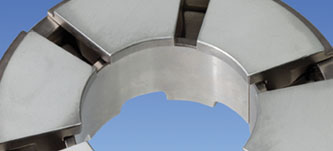
Tilting Pad Thrust Bearings
Kingsbury tilt pad thrust bearings are used in many types of applications.
Equalizing Designs vs Non-Equalizing
 In tilting pad thrust bearings the equalizing design distributes the load more evenly among the pads compared to a non-equalizing bearing and the load capacity is greatly improved over non-equalizing bearings. When a thrust load is applied, the thrust pad is designed to apply a load against the upper leveling plate which forces the lower leveling plates on either side to tilt slightly and raise the pads on the other side. This dynamic occurs on every pad and equalizes the thrust load. [Continue reading below]
In tilting pad thrust bearings the equalizing design distributes the load more evenly among the pads compared to a non-equalizing bearing and the load capacity is greatly improved over non-equalizing bearings. When a thrust load is applied, the thrust pad is designed to apply a load against the upper leveling plate which forces the lower leveling plates on either side to tilt slightly and raise the pads on the other side. This dynamic occurs on every pad and equalizes the thrust load. [Continue reading below]

Directed Lubrication Tilting Pad Thrust BearingsAs rotating equipment evolves, so do Kingsbury's product offerings. Read more. |

Flooded Lubrication Tilting Pad Thrust BearingsKingsbury thrust-pad flooded lubrication bearing designs are the result of over 100 years of actual field application. Read more. |
[Continued from above] While capacity is greatly improved over non-equalizing bearings, this design has some other effects. There are physical limitations such as loss of leverage due to shifts in pivot contacts. This results in a pad load differential that increases with mis-alignment and depends on the bearing geometry, contact radii, and the number of shoes. However, even with a high degree of misalignment, the hottest pad of an equalized bearing is still within a safe temperature range for continuous operation.
Non-Equalized tilting pad bearings are available from Kingsbury, such as the KingCole or NE models, for lower load applications especially in Europe which has used historically used non-equalizing designs.

Kingsbury Tilting Pad Thrust Bearing Animation
Directed Lubrication Designs vs Flooded Lubrication
Directed lubrication is a feature that provides more precise lubrication and cooler oil in tilting pad bearings allowing higher thrust loads and other advantages. Directed lubrication using the leading-edge-groove design was originally developed by Kingsbury and has been continuously improved. The bearing shoes and base ring are constructed so that cool undiluted inlet oil flows from the leading-edge groove in the bearing shoe directly into the oil film. The cool oil in the oil film wedge insulates the babbitt face from the hot oil carryover that adheres to the rotating collar.
Flooded lubrication provides a bath of oil over the bearing. It is used on lower speed and lower thrust force applications like some hydro turbines, pumps, compressors, and electric motors, but they can use almost any type of oil. The flooded-lubrication design is limited in capacity due to churn of the oil which creates friction and limits pressure, speed, and thrust.
To learn more about bearing performance incorporating different lubrication techniques, visit the following page:
- Performance Comparison of Leading-Edge Groove and Other Types of Bearings
- Fluid Film Thrust Bearing Design Comparison Using Different Lubrication Techniques
If your company needs support to determine which thrust design to use, please use our form to contact Kingsbury or call us.


